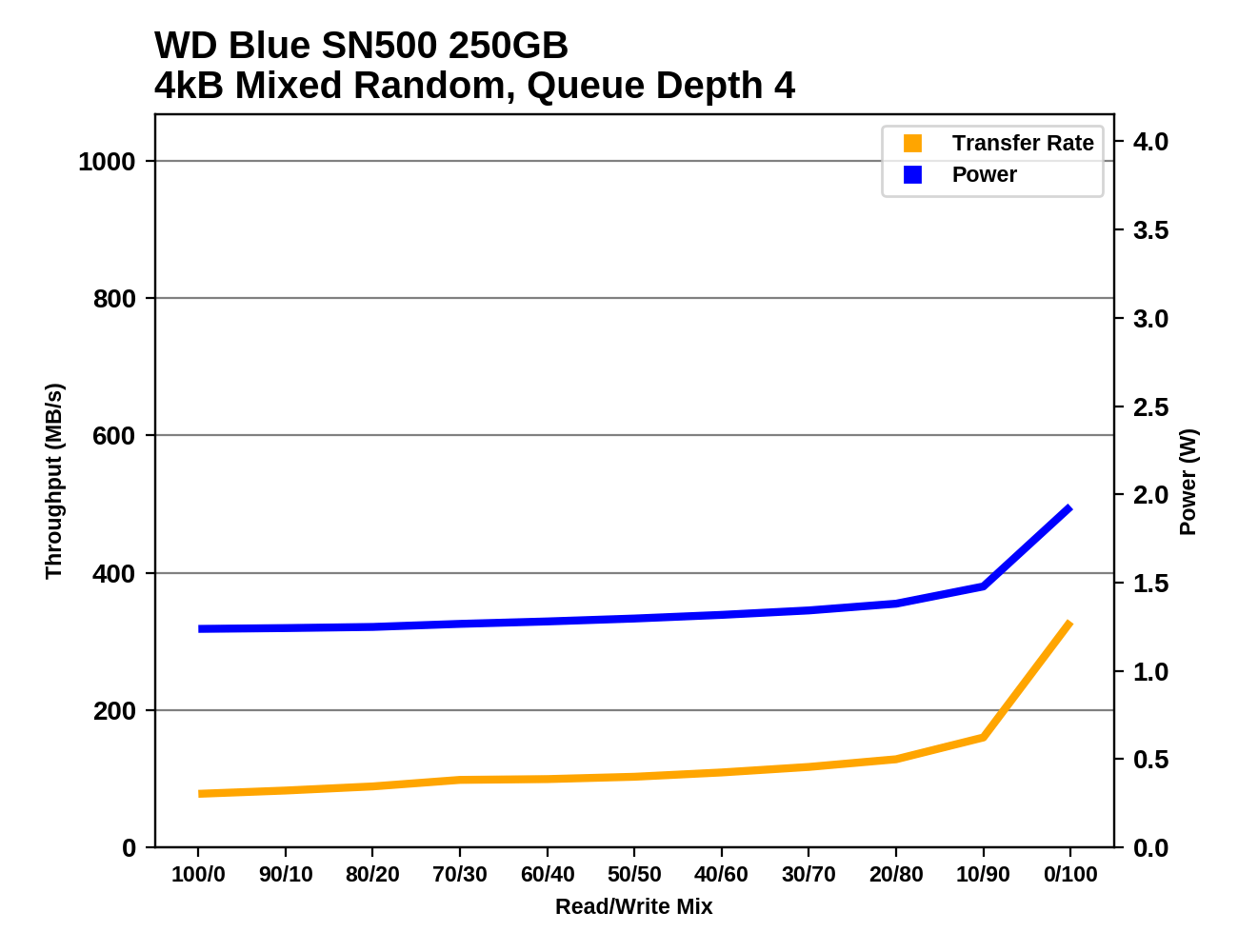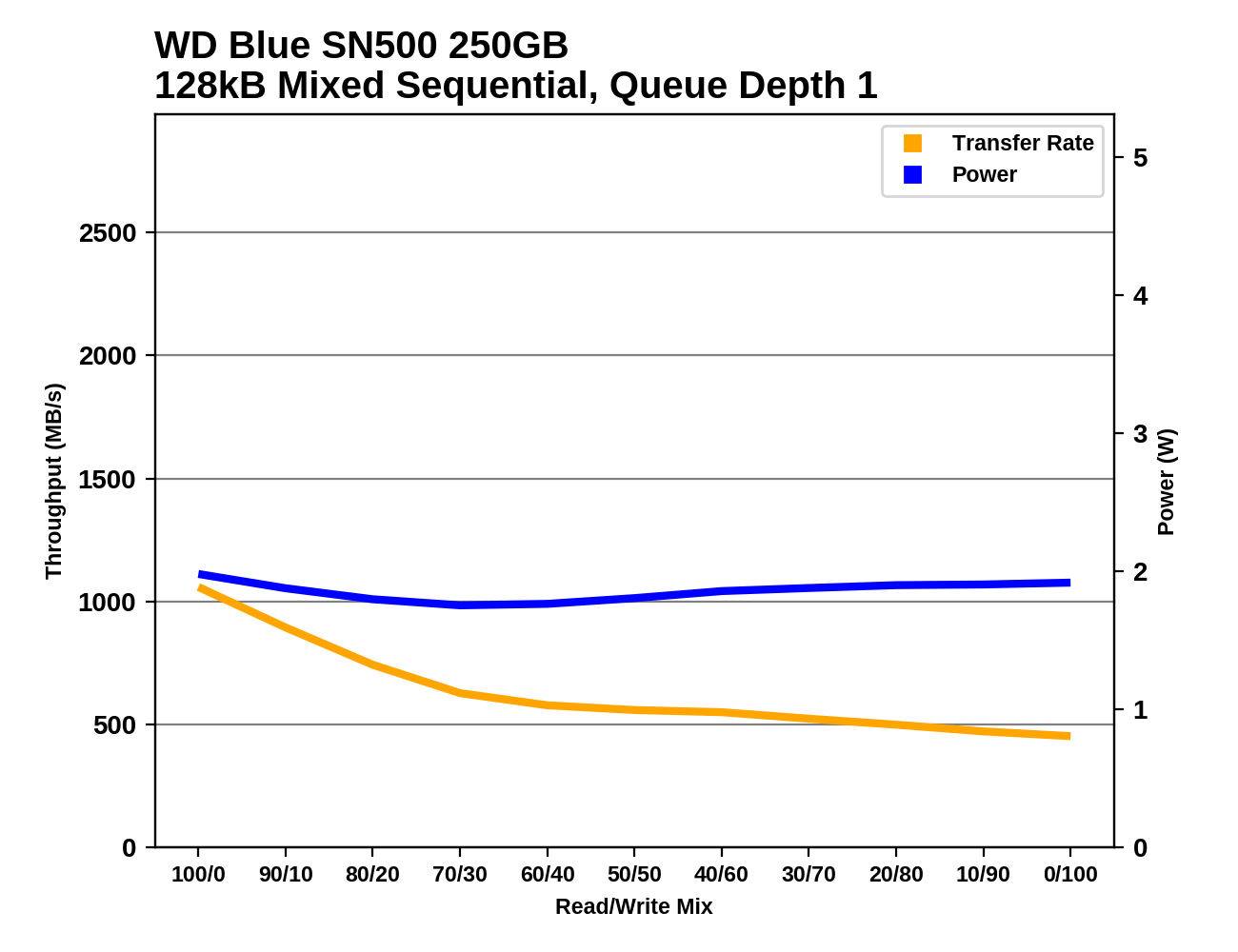The Western Digital WD Blue SN500 SSD Review: Moving The Mainstream To NVMe
by Billy Tallis on April 19, 2019 9:30 AM ESTMixed Random Performance
Our test of mixed random reads and writes covers mixes varying from pure reads to pure writes at 10% increments. Each mix is tested for up to 1 minute or 32GB of data transferred. The test is conducted with a queue depth of 4, and is limited to a 64GB span of the drive. In between each mix, the drive is given idle time of up to one minute so that the overall duty cycle is 50%.

The WD Blue SN500 is very slightly slower on the mixed 4kB random IO test than the larger WD Blue SATA SSD, and is significantly slower than the various high-end NVMe models. The other two entry-level NVMe drives are even slower than the SN500.
 |
|||||||||
| Power Efficiency in MB/s/W | Average Power in W | ||||||||
Despite relatively low performance, the WD Blue SN500's efficiency score on the mixed random IO test is a bit above average due to it drawing far less power than most of the high-end NVMe SSDs or even the SATA drives that outperformed it.
 |
|||||||||
The WD Blue SN500's performance on the mixed random IO test shows a fairly normal slow growth in performance as the workload shifts to be more write-heavy. At the very end, the ability to combine writes without any read operations getting in the way leads to a jump in performance even though the SLC write cache is full during almost all of this test.
Mixed Sequential Performance
Our test of mixed sequential reads and writes differs from the mixed random I/O test by performing 128kB sequential accesses rather than 4kB accesses at random locations, and the sequential test is conducted at queue depth 1. The range of mixes tested is the same, and the timing and limits on data transfers are also the same as above.

The WD Blue SN500 cannot compete with most of the high-end NVMe SSDs on the mixed sequential IO performance test, but it offers decent overall performance that is a bit higher than some of the other low-end NVMe drives and is a clear step up from any of the SATA drives.
 |
|||||||||
| Power Efficiency in MB/s/W | Average Power in W | ||||||||
The power efficiency of the SN500 on this test is quite a bit lower than what the 1TB WD Black SN750 delivered, but among other 256GB-class drives the SN500's efficiency is top-tier.
 |
|||||||||
As writes are added to the workload, the WD Blue SN500's performance drops—quickly at first, but then almost leveling out as the drive approaches SATA speeds. By the end of the test when the workload is pure writes, the SN500 is performing below theoretical SATA limits, but beats any actual 256GB-class SATA drive we have on hand.










50 Comments
View All Comments
kpb321 - Friday, April 19, 2019 - link
A lot of people don't need much space. I just upgraded my wife from a 128gb SSD to a 256gb SSD. The 128GB SSD was getting a little full because of pictures of our son and I was occasionally having to free up space for Windows update etc. We could have stuck with the 128gb and migrated her entire picture collection to the NAS or kept freeing up space when needed but a 256 SATA SSD is so cheap I figured why not upgrade. Her old 128gb got stuck in my in-law's computer to replace the old slow 500gb hd they had in the system. They are using less than half the space on that SSD so should be fine for a long time and if really needed I can always setup the 500gb hd as a secondary storage drive for them. The old days of 32/64gb SSD being barely adequate are passed. Windows + a decent selection of apps is fine on a 128gb SSD and 256gb gives even more head room.jabber - Saturday, April 20, 2019 - link
Been running my work laptop on a 64GB SSD for several years now. Some of us don't need to keep masses of data on a device that goes out and about. Sometimes carrying masses of data is a liability.RealBeast - Friday, April 19, 2019 - link
Don't know about mainstream, but no way that I would waste precious M.2 slots on some small slow drive like this one.Sure a .5-2TB, but not really a 660P for me (they should be on SATA ports at my house). I use those ports for fast drives.
beginner99 - Saturday, April 20, 2019 - link
In a laptop you might have a point but in a desktop? Put the OS on it and the most used apps like browser. If you don't game you are already set. For games you can use a hdd or a large cheap sata ssd as it doesn't really matter much what you use.stephenbrooks - Sunday, April 21, 2019 - link
If you have a lot of games you'll want both large capacity and fast access.But other than capacity, this "low end" NVMe drive looks great. It's clearly possible for them to do 1TB+ versions in the future too, in one way or another.
Korguz - Sunday, April 21, 2019 - link
fazalmajid you may not see it.. but others do.. for me.. i usually use a small drive for my C drive, aka windows drive, before it was 120, now.. as 120 gig drives have next to vanished, im using 250 gig drives, with other bigger drives for other things.. so when it come times for format, and install fresh.. instead of having to move and then redo a big drive.. all i have to deal with, is a small drive with little to no " i want to keep this so i need to move it to another drive " swapping...stephenbrooks - Sunday, April 21, 2019 - link
I found Windows wants to put "User" data and "Program Files" on the same primary drive, so it can grow in size and even end up containing data I want to keep, even if I try to separate the two.Korguz - Monday, April 22, 2019 - link
i check those 2 directories as part of the " i want to keep this so i need to move it to another drive " searching, and then moving... :-)tipoo - Friday, April 19, 2019 - link
I'd still be interested in seeing a T2 SSD (Apple) put through these paces. Usually they did great in sequential tests but not so much in 4k randoms, so I wonder how it would do on, say, Destroyer.kpb321 - Friday, April 19, 2019 - link
This drive did exceed my expectations for a x2 pci-e lanes with no Dram and no HBM but the pricing is going to be key. The SM2262 drives have gotten pretty inexpensive and don't leave a lot of room for a drive like this even as good as it may be for what it is. I just recently picked up the ADATA version of the HP EX920 @ $73 for the 480gb drive. That a x4 drive with dram on it and should beat this drive pretty consistently. Personally this drive would need to be down around $60 before I'd consider the price difference meaningful enough to consider this drive.